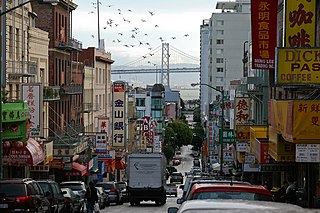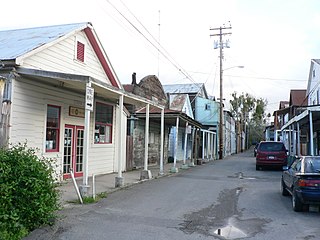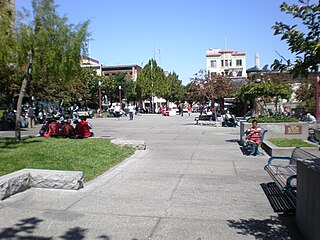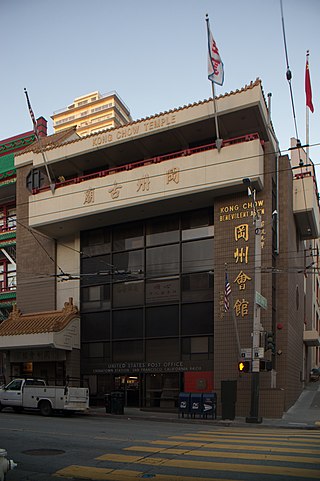
The Chinatown centered on Grant Avenue and Stockton Street in San Francisco, California, is the oldest Chinatown in North America and one of the largest Chinese enclaves outside Asia. It is also the oldest and largest of the four notable Chinese enclaves within San Francisco. Since its establishment in the early 1850s, it has been important and influential in the history and culture of ethnic Chinese immigrants in North America. Chinatown is an enclave that has retained its own customs, languages, places of worship, social clubs, and identity.

Locke, also known as Locke Historic District, is an unincorporated community in the Sacramento–San Joaquin River Delta of California, United States. The 14-acre town (5.7 ha) was first developed between 1893 and 1915 approximately one mile north of the town of Walnut Grove in Sacramento County.

Portsmouth Square, formerly known as Portsmouth Plaza, and originally known as Plaza de Yerba Buena, or simply La Plaza, is a one-block plaza in Chinatown, San Francisco, California. Portsmouth Square is the first park in San Francisco, predating both Washington Square (1847) and Union Square (1850). Established in the early 19th century, during the period of Mexican California, the plaza was renamed following the U.S. Conquest of California in honor of the USS Portsmouth, the American ship which captured the city. It is bounded by Kearny Street on the east, Washington Street on the north, Clay Street on the south, and Walter Lum Place on the west.
This is an alphabetical index of topics related to Asian Americans.

The Chinese Culture Center of San Francisco is a community-based, non-profit organization established in 1965 as the operations center of the Chinese Culture Foundation located in Hilton San Francisco Financial District, at 750 Kearny Street, 3rd Floor, San Francisco, California, United States.
The Adopt-An-Alleyway Youth Empowerment Project is a non-profit project of the Chinatown Community Development Center that is based in the San Francisco Chinatown area.
Him Mark Lai was a historian of Chinese American descent, a leader of the Chinese-American community, and writer. He helped restore the state of Chinese American historiography. Lai "rescued, collected, catalogued, preserved and shared" historical sources in Chinese and English. He was known as the "Dean of Chinese American history" by his academic peers, despite the fact that he was professionally trained as a mechanical engineer with no advanced training in the academic field of history. The Chronicle of Higher Education named Lai "the scholar who legitimized the study of Chinese America".

Grant Avenue in San Francisco, California, is one of the oldest streets in the city's Chinatown district. It runs in a north–south direction starting at Market Street in the heart of downtown and dead-ending past Francisco Street in the North Beach district. It resumes at North Point Street and stretches one block to The Embarcadero and the foot of Pier 39.

The Chinese Historical Society of America is the oldest and largest archive and history center documenting the Chinese American experience in the United States. It is based in the Chinatown neighborhood of San Francisco, California.

Chinatowns are enclaves of Chinese people outside of China. The first Chinatown in the United States was San Francisco's Chinatown in 1848, and many other Chinatowns were established in the 19th century by the Chinese diaspora on the West Coast. By 1875, Chinatowns had emerged in eastern cities such as New York City, Boston, Pittsburgh, and Philadelphia. The Chinese Exclusion Act of 1882 barred Chinese immigration to the United States, but the Magnuson Act of 1943 repealed it, and the population of Chinatowns began to rise again.

Kong Chow Temple is a temple dedicated to Guan Di, located in the Chinatown neighborhood of San Francisco, California, in the United States.
Philip P. Choy was an architect and historian of Chinese American studies. He is the author of San Francisco Chinatown: A Guide to Its History & Architecture (2012), Canton Footprints: Sacramento’s Chinese Legacy (2007), and The Coming Man: 19th Century American Perceptions of the Chinese (1994). Choy has been a community activist known for landmark preservation in San Francisco.

Ross Alley is a north–south alley in San Francisco's Chinatown. Ross Alley lies between and is parallel to Stockton and Grant, running one city block between Jackson and Washington.
As of 2012, 21.4% of the population in San Francisco was of Chinese descent, and there were at least 150,000 Chinese American residents. The Chinese are the largest Asian American subgroup in San Francisco. San Francisco has the highest percentage of residents of Chinese descent of any major U.S. city, and the second largest Chinese American population, after New York City. The San Francisco Area is 7.9% Chinese American, with many residents in Oakland and Santa Clara County. San Francisco's Chinese community has ancestry mainly from Guangdong province, China and Hong Kong, although there is a sizable population of ethnic Chinese with ancestry from other parts of mainland China and Taiwan as well.
Sexuality, including same-sex sexuality, and other non-normative forms of sexuality have been central to the history of Chinatown, San Francisco. San Francisco's Chinatown, founded in 1848, is the first and largest in the United States. San Francisco was shaped by early Chinese immigrants, who came from the Guangdong province of southern China. These immigrants gathered in the Bay Area in order to join in the California Gold Rush and to build railroads in the American West. San Francisco's Chinatown made room for these early Chinese immigrants to live, and the area turned into a "bachelor society", where female prostitution was pervasive because of the Chinese Exclusion Act. As a racialized immigration region, Chinatown was viewed as an immoral place with the characteristics of "vice", "sluttery" and "sexual deviance" for a long time. These traits were incompatible with the mainstream culture and dominant norms of American society. From the mid-19th century, the state problematized Chinese female prostitution with the subject of sexual transmission, and the government began to go against industrial prostitution in Chinatown, as well as Chinese immigration. As the sex industry grew throughout the Bay Area, the government had to stop the anti-prostitution and anti-immigration law in the beginning of the 20th century. Just like the Castro district and other areas, Chinatown developed its own sexual industries and provided a variety of sexual entertainment to both immigrants and white visitors.
Maria Seise was the first Chinese woman to immigrate to California, arriving in Hawaii in 1837 and San Francisco in 1848.

Gordon J. Lau Elementary School, founded as The Chinese School and was once named Oriental Public School, was a public school located in Chinatown, San Francisco, California. It was initially set up in 1859 as a segregated school for schoolchildren of Chinese descent, part of the growing anti-Chinese sentiment in the United States that arose in the late 1800s. The school has been renamed a number of times, most recently in 1998 to its current name in honor of the city's first Chinese-American supervisor.
Emma Ping Lum (1910-1989) was the first Chinese American female lawyer in the United States and California.
Charles Marion Rousseau (1848–1918) was a Kingdom of Belgium-born American architect. He was an early architect in the city of San Francisco, California. He co-founded the architecture firm Rousseau and Son, and raised three sons that became noted architects.
Andrew J. Moulder was an American educator and author who was the superintendent of schools in California and superintendent of schools in San Francisco. He supported excluding minorities from public schools in California.










